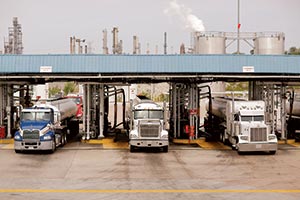Senior Reporter
Diesel Falls 4.1¢ to $2.071; Below $2 in Two Regions

The U.S. average diesel retail price fell for the 11th consecutive week, dropping 4.1 cents a gallon to $2.071. That includes two regions that dropped below $2 a gallon for the first time in nearly seven years, the Department of Energy reported.
Trucking’s main fuel is 79.5 cents a gallon cheaper than a year earlier and remains at its lowest level since March 9, 2009, DOE said after its Jan. 25 survey of fueling stations.
“We are kind of swimming in diesel right now, the blast of winter weather [along the East Coast] notwithstanding,” said Denton Cinquegrana, an analyst with the Oil Price Information Service.
Once again, the average diesel price fell throughout the entire country, with the lowest averages at $1.957 in the Gulf Coast region and $1.987 in the Midwest, according to DOE.
Diesel last was below $2 in both regions on March 16, 2009, when the price in the Midwest was $1.964 and in the Gulf Coast at $1.974, DOE said.
The agency also reported that the average retail price of regular gasoline fell to $1.856, down 5.8 cents from the previous week. It is down 18.8 cents from a year earlier and is the lowest since Jan. 26, 2009, when the price was $1.838.
Also last week, crude oil futures climbed back above $34 a barrel on the New York Mercantile Exchange, a three-week high, after Russia’s energy minister reportedly said OPEC and other producers will meet in March to discuss a potential production cut.
“Many analysts think that the first quarter will be very volatile in prices but that crude production will decline [in] the second half of this year and the oversupply balancing will take place,” Stephen Sly, president of the risk management firm Stabilitas Energy Inc., wrote in a daily energy briefing Jan. 25.
That can leave fleets facing a “barrage” of different pricing information at a time when fuel margins are “historically as high as they have ever been,” Jake Zuanich, president of the fuel card provider P-Fleet, told Transport Topics.
In this environment, “trying to find cost-plus arrangements [the wholesale price of diesel plus a margin] can be very advantageous and can save fleets quite a bit of money because they are the ones benefiting from that large retail spread,” Zuanich said.
OPIS’ Cinquegrana said ultra-low-sulfur diesel on the futures market was as low as 95 cents a gallon. But downstream, wholesalers appeared to be having trouble selling it.
“So you are seeing some [wholesalers] get pretty aggressive on the prices,” he said. “If you are a large retailer, . . . you are going to be able to pull some pretty cheap numbers. I am looking at some [rack] numbers that are discounted to the futures market by, in some cases, at least 10 cents and a lot of times even more.”
Meanwhile, DOE said oil stocks in Cushing, Oklahoma, were 63.4 million barrels for the week of Jan. 22, down 1.2% from the week before but up 63% from a year earlier.
Gasoline stockpiles climbed 3.5 million barrels to 248.5 million barrels, the highest since 1990. Supplies of distillate fuel, a category that includes diesel and heating oil, fell 4.1 million barrels to 160.5 million, the biggest decline since October 2014.




